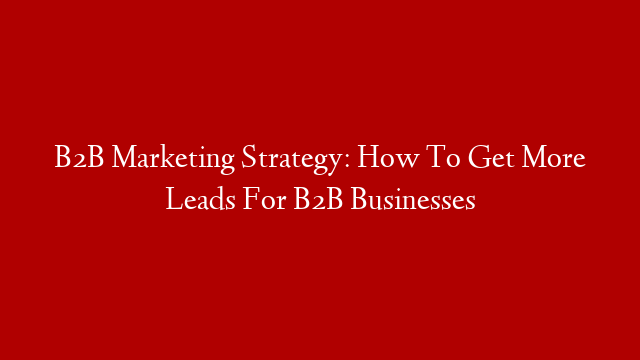We all know the importance of B2B lead generation when it comes to helping your sales team reach their sales quota. It’s a simple situation that many B2B marketers and sales professionals have had heated debates and fights over.
No leads. No sales.
No sales. No business.
And if the leads aren’t great… That’s on the marketer.
But here’s the thing:
It doesn’t have to be this way!
In this video, I break down 9 different tactics that B2B marketers can embrace to increase the volume of leads while ensuring that they’re high quality leads.
0:00 This is for B2B marketers
0:11 We need more leads!
0:44 Make your emails stand out
2:15 Share valuable insights
4:27 How Jason Lemkin (SaaStr) uses Quora
5:31 Engage with relevant industry communities.
7:06 Utilize LinkedIn ads
7:50 Leverage Facebook Groups
9:12 Create or join a Slack Community
10:11 Distribute your content!
10:51 Create partnerships with other B2B brands
11:56 Leverage Medium to syndicate content
13:29 Optimize CTAs in your signature
I’m going to show you how to attract quality leads, build trust with them online and ensure that your B2B brand (whether service or product) can have a solid pipeline that you’ll never lose sleep over because you’re wondering if sales is going to try and fight you during the next company meeting.
These are some of the best ways B2B brands can generate leads and a sure-fire way to ensure that at the end of the quarter both marketing and sales teams are poppin’ a bottle of Dom Perignon together.
One of the first things any great B2B marketer does before implementing a B2B marketing plan is identify their target audience and learn everything they can about them. Identifying a B2B target audience is a bit more difficult than it is in B2C situations because there’s so many people that influence the decision in B2B.
You see, when it comes to B2C, the purchase decision-making process is typically much faster and comes down to one person making the call. Because of this, you can understand the individual pain points that this person has and focus solely on those.
For most B2B purchases, we’re not talking about a $20 t-shirt or $6 phone case (unless it’s a bulk purchase). Most of the transactions that happen in B2B have a bigger average cart size and could be considered major purchases.
In many cases, these purchases require buy-in from multiple levels within an organization. It’s not just the senior marketer that approves your project, it’s procurement, the VP of digital, and the CTO who all have an influence on that transaction.
So figuring out EXACTLY who your audience is KEY!
You see, instead of just targeting Aaliyah, the CEO of that Fintech company you’d love to work with, you’re also going to be targeting the CMO Erin, CFO James, CTO Alicia, and the Sr. Marketer Josh that you used to work with at your old company. And the way you reach James might be different from the way you reach Erin or Josh.
That’s why it’s so important to keep track of the various touchpoints, how they’re happening, and use that data to better understand what type of content they want, how they want to receive it, and whether or not they’re warmed up enough to go in for your pitch.
That’s the role of internal data.
And it’s internal data that will help you better understand exactly who you should be talking to in the first place. As a starting point, you should look at who your best customers are:
Which customers see the most value in your product or service?
Which customers have you given the most value to?
What content does your audience consume online?
Which customers does your team love serving?
Which customers give you the most love?
All of these answers should assist in helping you figure out EXACTLY how to use the different strategies and tactics I break down in this video.
=========
Full Blog Post here:
👋🏾 Let’s stay connected
╰ Subscribe to my channel:
╰ Instagram:
╰ Twitter:
Great Slack Channels:
Great Medium Publications:



